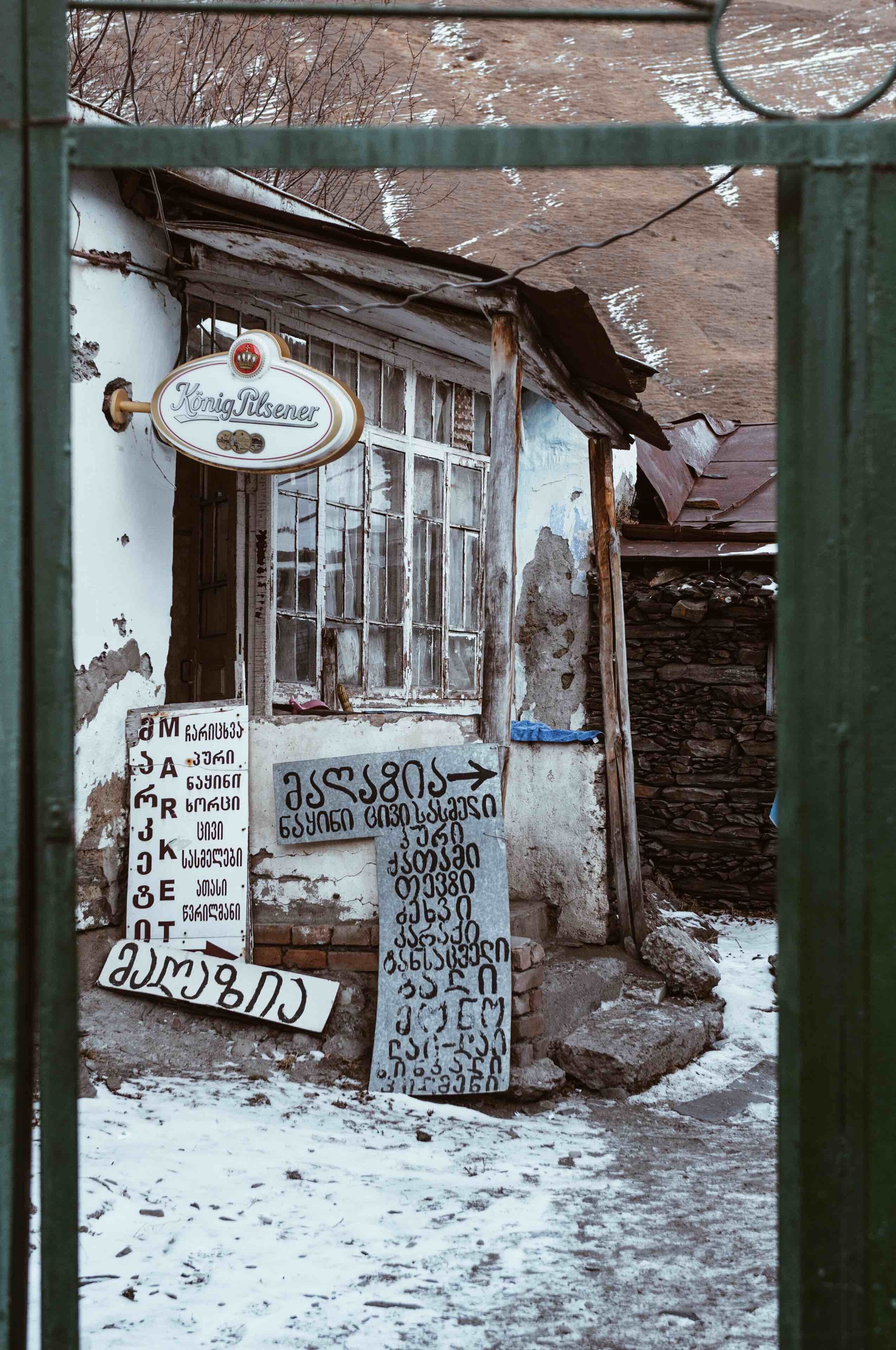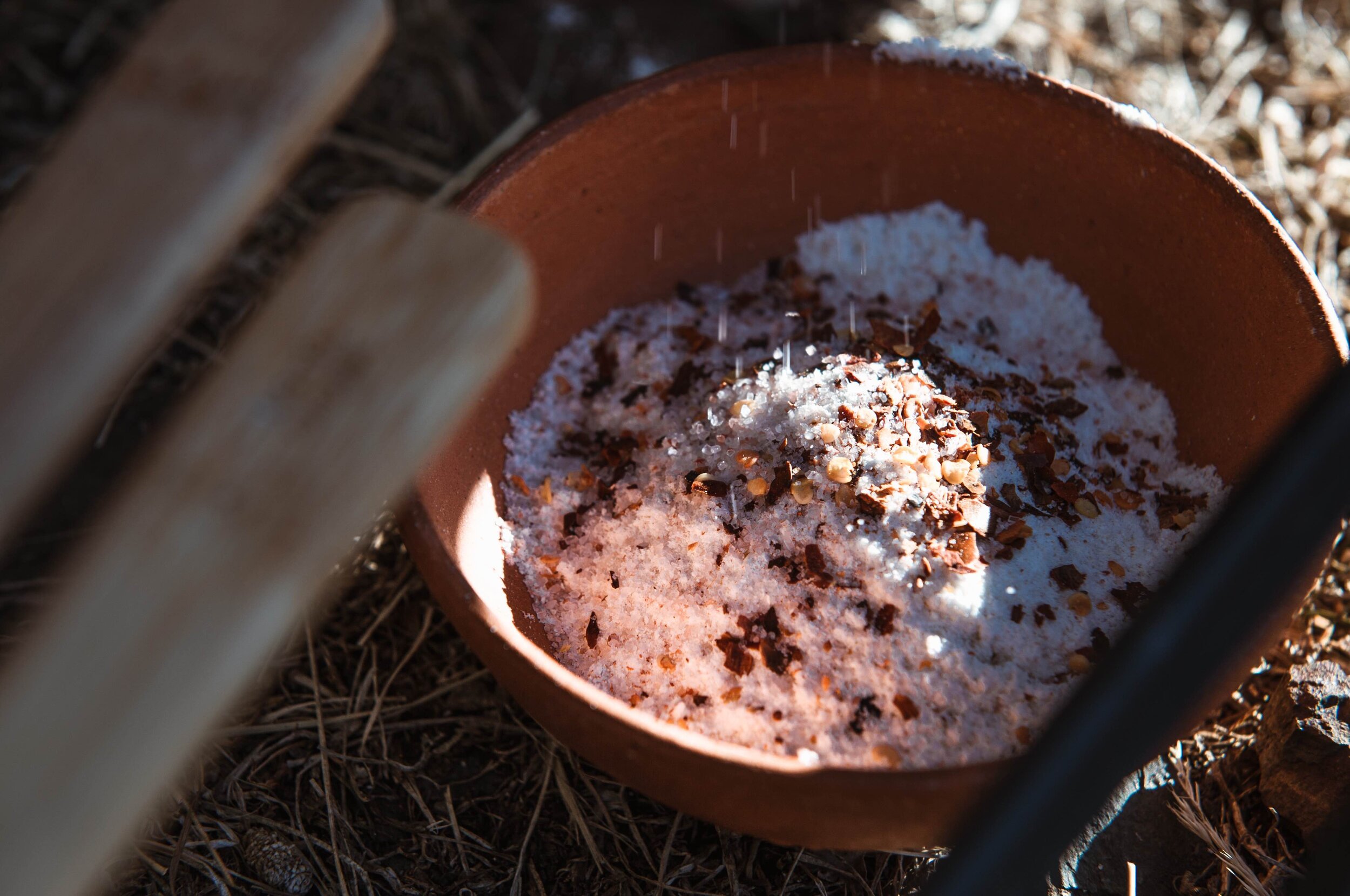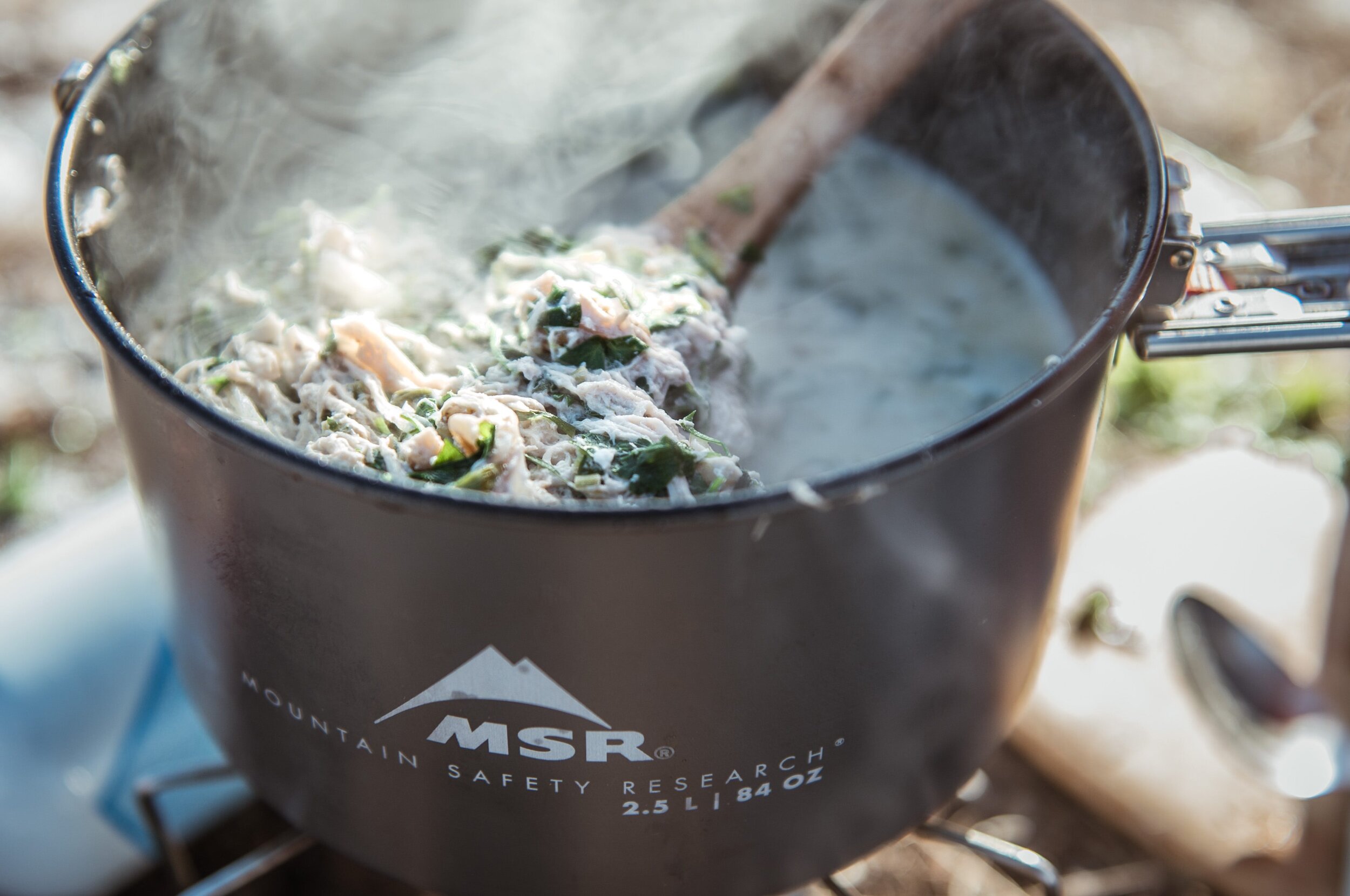Wild cooking in the Caucasus
Expedition chef and mountain instructor, Kieran Creevy, redefines camp cooking high up in Georgia’s Caucasus Mountains. Photos by Lisa Paarvio.
The Lada Niva’s engine whines in protest as the rev counter approaches the redline. Tyres squirm for grip in the loose snow. Vasil, our driver, calmly smooths out the drift and slingshots his car into the next hairpin bend. Behind our heads, our axes, shovels, snowshoes and crampons create a cacophony of steel and aluminium, contrasting the rubber and leather squeaks and tinny rattles from the Niva.
High in the Kazbegi Caucasus, Lisa and I have packs loaded with food, equipment and camera gear for a multi-day snowshoe and wild camping adventure. A few days earlier, we met Vasil by chance. One of those unexpected meetings that expands your knowledge and alters your world view. We got a detailed primer to decades of hard-won local information. Info on which market to find the best pickles, fresh vegetables, strained yoghurt, and local specialties like dried sour plums and walnuts — an integral element for many Georgian dishes. One such market gave us pause; from the outside, the ramshackle, faded facade spoke of a store long past its heyday. But its dimly lit interior revealed a trove of wonders: fruit leather with a mouth-puckering sourness, tangy cheeses, wild herb medleys, delicate beetroots and pungent onions with a green/white hue.
The market visit also pulled into sharp focus the division of labour in this area. On our hike into town there were no women on the road, only men. All the taxis and tourist agencies are operated by men. Yet inside the market, in cafes and in restaurants the staff are almost always women. It’s as though we’re in the 1950s.
After a dinner of local specialties in one of the small restaurants, Vasil drives us back to our base for the week, revealing a treasure trove of possibilities on the way for trekking, ski touring and mountaineering in the area. After only thirty minutes, we have at least a month’s worth of options. We need to head out for a recce.
The next morning we shoulder our packs early and head down a snow-covered road, scoping potential trails. Within the first ten minutes we have had four offers of lifts from local drivers, curious as to what we’re doing out this early with laden packs. On the fifth offer, our resistance crumbles and we gratefully accept a lift down the road to the appropriately named Sno village. Thanking our driver, I offer him a ten lari note. His response is a swift ‘I’m not a taxi’. Fearing I’ve made a faux pas, I look to see if he’s annoyed, but the beaming smile is its own answer. This generosity of spirit is present in nearly every Georgian we meet throughout our trip.
Our entrance into Sno is across an off-kilter suspension bridge with some planks missing completely. Luckily the river is only metres below us, not the yawning chasms you might encounter in the Himalaya. We find a village almost in hibernation mode. The high peaks and narrow valley floor create a sun shadow that covers most of the houses. Doors and windows are closed and shuttered, though snatches of laughter reveal life within. There are gardens with old-style haystacks and greenhouses with broken panes. Rusted trucks without windows lie canted on two wheel hubs, the rubber cracked and degraded in the deep cold. Around one corner we have a face-off with a cow — Lisa swiftly checking to make sure we’re not playing chicken with the village bull.
Eventually we’re on the correct track to the trailhead. Once on the mountain, we can begin to make sense of the landscape and terrain. A multi-day itinerary starts to take shape in our minds. Checklists can be made and crossed off. In this deep cold we will have to find a water source at some point, otherwise we will be melting snow for hours. Heading home for the night, we’re already excited for the adventure ahead.
That evening, the ritual of sorting gear begins. Just enough clothing to keep us warm and dry, with spares for those ‘in case’ moments. Winter sleeping bags have expanded in the house, which now have to be tightly stuffed back into dry bags. We won’t be eating freeze-dried meals on this trip, only Georgian-inspired dinners and breakfasts. Food canisters, silicone pouches and dry bags get packed with food for three days.
Morning comes all too early. We briefly question our respective career paths, but the magnetic pull of new mountains is all the incentive we need to get out the door. One wild ride up a twisting mountain road in that rattling Lada Niva to our drop off point, and we’re alone! Just us and an amphitheatre of peaks, radiant under starlight.
Shafts of gold break the horizon and we pause for morning tea and fresh bread. Time to soak up a little heat. We head deeper into the hills on worn goat trails. Our snowshoes and ice axes still packed. Though we’re almost at 3,000 metres and it’s minus twenty, the snow is sparse and patchy. We encounter the first signs of long habitation in this wild corner of Georgia. A ruin of a shrine, its stones worn smooth with centuries of age.
Late in the day, we chance upon a perfect spot for our first camp. The spur widens enough for a comfortable pitch. In the midst of setting up camp my stomach growls. Time to make dinner. Cocooned in layers of silk and down, we fall asleep to the deep silence of remote winter peaks.
Plumes of breath swirl and dance above me in the light of my head torch. To my left, I can hear Lisa curl deeper into her sleeping bag. It’s my turn to make breakfast. First order of business: thick, hot coffee. Easing my way slowly through the narrow door, the fly sheet slithers and crackles in the cold. The sting of freezing air causes an involuntary cough. Burying my face into the hood of my jacket I jog on the spot to create heat. With coffee made and grateful mumbles of thanks from inside the tent, I can get to work prepping our breakfast.
Our winter adventure in this mountain fastness speeds by all too fast. Days pass in a kaleidoscope of sensory wonders: the smell of snow on the wind, moonlight glinting off shards of ice as though the ground is carpeted in diamonds, a dense forest hiding a stone fortress, hot spiced soup, and the joy of travelling in the wilderness with a close and trusted friend.
Finally, we near our home, the hillside showing small signs of traffic — a slight widening in the trail. But we don’t want to break the spell of the wilds and return straight to civilisation. Our last mountain lunch is suddenly interrupted by a wild street dog. Whether it caught scent of our meal or is in search of company we don’t know. It approaches camp, relaxed and at ease. Lying down, it seems content, but with the expectant air of one hoping for some food in the future.
Our time in Georgia has left us astounded by the sheer number and friendly manner of all the street dogs we have encountered on our journey so far. Not one has approached us with menace. Though they obviously live semi-wild, their manner seems to suggest that locals treat them with respect and human kindness.
After lunch, as though loath to let us escape its enchantment, the Kazbegi Caucasus throws us a last curveball. The track we were on disappears with no warning. Far ahead we can see the continuation of the track, and a kilometre away our home. Between us and it, however, is a wide river. Backtracking will take us a few hours. We decide to scout the bank, hoping for stepping stones or a narrow stretch over which we can jump. No joy. Just as we’ve made the decision to turn back, Lisa spots a possible ford. Assessing the speed and depth of the flow, we’re in luck. It’s safe.
Splashing our way across, we emerge and almost immediately the hems of our trousers freeze into board-like stiffness. Bone-tired and wet we may be, but the enchantment has struck us hard. We’re in the thrall of this magnificent landscape and its people. Thank you Georgia.
Georgian Caucasus Menu
Lobio with Mchadi
(Red bean, pepper, onion and herb stew with cornbread)
Ingredients (serves 2):
Lobio
2 cups dried red kidney beans, soaked in water overnight
1 white onion, finely sliced
1 green pepper, roughly diced
1 cup flat leaf parsley, roughly chopped
1 vegetable stock cube, crumbled
1 tsp white pepper
1/2 tsp dried fennel powder
1/2 tsp black cumin powder
1/2 tsp coriander powder
Water
Salt — to taste
1 tbsp butter or ghee
Mchadi:
Cornflour, finely ground
2 eggs
2 tsp sea salt
1 tsp chilli flakes
1 cup hard white cheese, cut into fine cubes
2 tbsp rapeseed or olive oil
Water
Extra cornflour for dusting
Equipment:
Camping stove, pump and fuel bottle
Ceramic pot and skillet
Wooden spoon and spatula
Silicone dry bag — to knead and store the dough
Storage:
Mix the beans, parsley and stock cube together and store in a lightweight leak-proof container. Store the onion, pepper and spices in a separate container.
Method:
First make the cornbread.
Mix together the cornflour, spices, salt, eggs and oil.
Then add in the cheese and a little water at a time.
Knead until you have a smooth dough.
Store in a silicone dry bag or reusable container.
Light the stove and when burning correctly reduce the heat to a simmer.
Add the butter/ghee and when gently sizzling add the onion, pepper and spices.
Cook for 2-3 minutes.
Add the bean mix, stir well and ensure there is enough water to cover completely.
Increase the heat to full, cover with the pot lid and bring to a boil.
Reduce heat slightly, cook for 20 minutes or until the beans are soft, adding more water if necessary.
Taste and season with salt if needed.
Remove from the heat and keep warm.
Place the skillet on the stove, reduce the heat to medium/high.
Break off a golf ball size lump of dough, roll in between your hands until smooth and flatten.
Dust with a little cornflour and place in the skillet.
There is space in the skillet for 2-4 breads, depending on size.
Dry fry for a few minutes on both sides until cooked through and the cheese starts to ooze out.
Serve the bean stew in an insulated container with some bread.
Chicken Satsivi soup — winter camp version
Ingredients (serves 2):
Cooked meat from thighs and one breast of chicken. (Slow cook in the oven and when cold pull the meat apart with forks or your hands)
1 cup walnuts, smashed to fine chunks/powder
1 cup coriander leaf
1 cup parsley leaf
4 cloves garlic
1/2 onion
1 glass white wine
1 cup sour cream
2-3 cups water (depending on how thick you like your soup)
1 chicken stock cube, crumbled
1 tsp ground black pepper
1 tsp hot paprika
1 tsp dried tarragon
50 g butter (wrapped)
Sea salt
Equipment:
Camping stove and pot
Bamboo chopping board
Knife
Airtight container
Insulated bottle
Insulated coffee mug with airtight lid
Wooden spoons
Insulated bowl/mug — to serve
Method (cooking in camp)
Put the pulled chicken into an airtight container, and chill in the fridge overnight.
Use this to transport to camp.
Mix the wine and sour cream together and transport in a leak-proof coffee mug.
Fill your bottle with water.
Place the spices, stock cube and walnuts in a small reusable container.
Place the herbs, onion and garlic and butter in another reusable container.
Hike to your chosen lunch spot, or overnight camp.
In camp, finely chop the herbs, garlic and onion.
Heat the pot, add butter and foam gently.
Add the onion, garlic, herbs and spice/walnut mix; cook for 2 minutes.
Add the wine, sour cream and water, bring to a simmer.
Add the shredded chicken and cook for 15 minutes minimum. (If you have the time and fuel, cook for longer as the flavours will intensify.)
Taste and season if needed.
Serve in the insulated bowls/mugs.
Dig in!
Stoves, pots and snowshoes from Mountain Safety Research, and knife from Morakniv.










